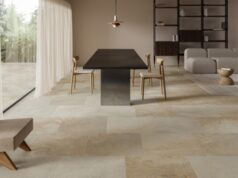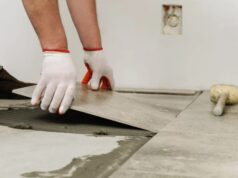
Particleboard sheet flooring is used to cover large expanses of floor quickly and cheaply, providing a base for other flooring finishes.

Image courtesy of Carter Holt Harvey Woodproducts Australia.
What is particleboard?
Particleboard sheet flooring (often referred to as chipboard, or tongue-and-groove sheeting) is used to cover large expanses of floor quickly and cheaply, providing a base for other flooring finishes like carpet and floating floor to be installed on.
Particleboard consists of small wood chips bound together with a resin which is then compressed. It’s not as strong or as durable as solid wood, and is highly susceptible to water and physical damage, especially chipping, but is produced in large flat panels that can cover an area very quickly. This can, however, be a disadvantage when compared with wooden floorboards. While it’s relatively easy to replace a single damaged floorboard, it’s not necessarily so easy to replace an entire particleboard panel. Waterproofing can assist to a certain degree, but it is best not to use particleboard where water has any chance at leaking through.
What is particleboard made of?
The wood chips used in particleboard can come from a variety of sources, but they mainly come from factory offcuts, shavings and sawdust which has been crushed down. The chips are mixed with a synthetic resin or other binding agent and then compressed into shape.
Are there variations in particleboards?
Particleboard is available in varying densities; higher density particleboard is stronger. Another method of production which strips out the wood fibres and compresses those with a resin and wax mix produces the much stronger fibreboard. Particleboard is available in a range of thicknesses and sheet sizes, to compensate both for the intended usage and for the spacing between flooring joists (which is typically either 450mm or 600mm).
How is particleboard installed?
Particleboard is very simple to install because it’s easy to cut and nail down, and covers a wide area. First, the total area to cover is measured then divided by the size of the board to determine how many are necessary. The boards are laid down and nailed into place through the joists, ensuring there’s a tight fit between each board. The edges and corners are left for last as it is likely that you’ll need to cut the board to fit.
Where is particleboard used?
Particleboard is an incredibly common choice for a floor base as it is so cheap and easy to install. It is versatile too, and is commonly used with vinyl, linoleum tiles and carpet. If covered properly and sealed to be waterproof, it can also be used in bathrooms and laundries, though its vulnerability to swelling and crumbling when exposed to water can limit its use in wet areas.
|
Advantages
|
Disadvantages
|





